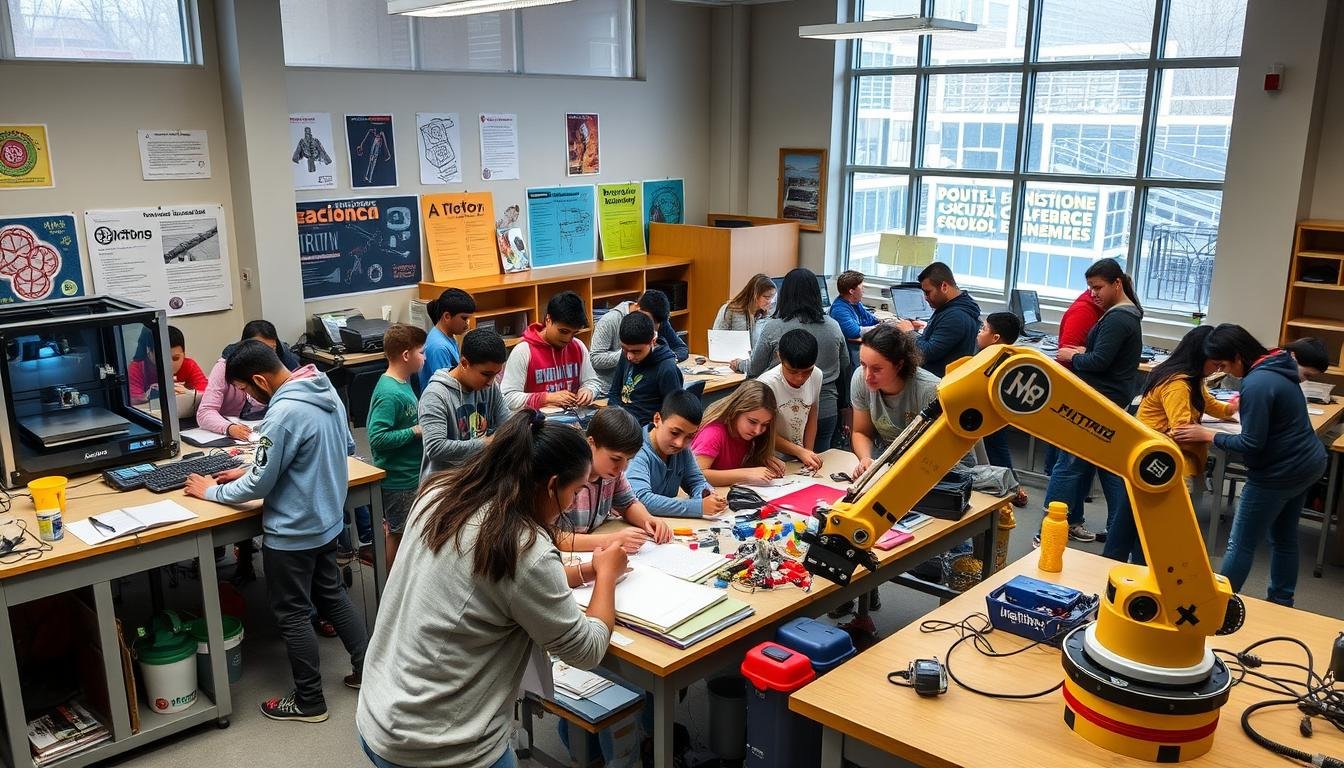America’s education system is facing tough questions. Critics say we need to fix the education crisis that’s growing. They point out big problems in how we teach and if it really helps students learn.
Natalie Wexler has written about the lack of deep learning in elementary schools. This problem affects students, especially those from poor or vulnerable backgrounds. They struggle because the education system isn’t balanced.
More bad news: American students are falling behind in important subjects. Teachers are leaving in droves. These issues show a system with big problems and fights over rules that get in the way of learning.
These problems are not just about rules. They are a big worry for America’s future and its young people.
Key Takeaways
- The United States lags internationally in education, demonstrated by PISA rankings.
- Stagnation in reading and math skills over the past decade signals deep-seated issues.
- Teacher departures, heightened in the pandemic era, indicate systemic stress.
- Political disputes over educational content threaten diverse learning experiences.
- Restrictions on curriculum content may stifle students’ social and historical understanding.
- The nexus of women’s educational attainment and reproductive rights highlights broader societal issues intersecting with education.
- Repercussions of education policy extend beyond classrooms into economic and cultural realms.
Dissecting the Knowledge Gap: American Educational System’s Hidden Flaw
The American educational system aims high but faces big problems. A major issue is the failed education system that doesn’t connect teaching methods with reading comprehension. This gap hurts educational fairness and shows the disparities in education and underreported issues in education.
The Misalignment Between Teaching Methods and Reading Comprehension
Reading comprehension is key to success in school. But, today’s teaching methods often focus on memorizing facts rather than understanding them. This gap shows a big problem in how we teach, making it hard for students to think critically and solve problems.
The Undermined Value of Fundamental Knowledge in Schools
Schools often value skills over knowledge, which is a big mistake. This lack of focus on knowledge-based education is a major problem in our failed education system. Without a strong base of knowledge, students can’t do complex thinking and learning. This is especially hard in poor areas where schools have less resources, making these underreported issues in education even more critical.
To fix our schools, we need to teach both knowledge and skills together. This mix will improve reading comprehension and get students ready for a complex world. It’s a step towards fixing our failed education system and closing the disparities in education.
The Education Crisis We Don’t Talk About: Unveiling America’s Dark Secrets
Looking into unaddressed issues in education, we must understand the past. The General Education Board (GEB) was founded by John D. Rockefeller in 1902. It aimed to standardize education, focusing on memorization, and ignored other learning methods.
img src=”https://seowriting.ai/32_6.png” alt=”Unaddressed issues in education”>
This method, pushed by powerful figures like Rockefeller, aimed to create a compliant workforce. It led to education inequality, especially for minority groups like Native Americans. Their histories and perspectives are often overlooked, if mentioned at all.
- The standardized curriculum stifled creative and diverse educational models.
- Rockefeller’s efforts to control the workforce still affect education today, causing unnoticed challenges in schools.
- In places like North Carolina, Native American students face a significant achievement gap, showing ongoing educational inequities.
These insights highlight the hidden aspects of the educational system that many overlook. To achieve true educational equality, we must acknowledge these historical impacts. It’s crucial to recognize and tackle these systemic issues as barriers to true educational fairness.
Rethinking Elementary Education: The Crucial Role of Rich Content
Elementary education is key to future learning. It lays the foundation for deep content knowledge. A rich, well-rounded curriculum is vital, especially for vulnerable students.
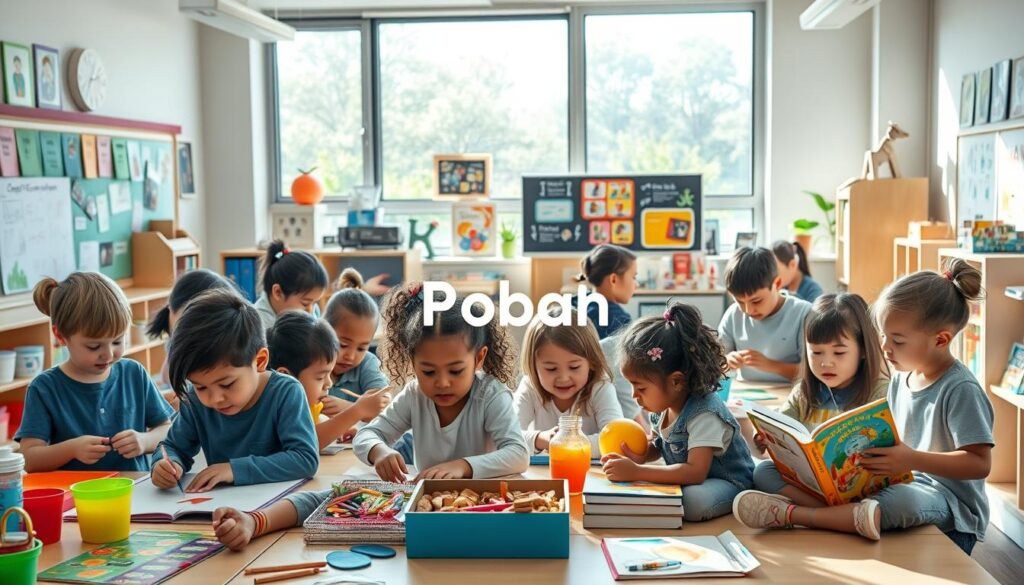
Creating a critical curriculum in early education is more than just meeting basic needs. It’s about building a dynamic environment for exploration. This environment solidifies important academic and social skills.
Necessity of Deep, Rich Curriculum in Early Education
Enhancing educational support in elementary schools is crucial. In today’s world, critical thinking and problem-solving are essential. The curriculum should be deep and broad, not just superficial.
Subjects like science, history, and the arts are key. They help children understand the world in a comprehensive way. This approach moves away from rote learning and towards independent thinking and real-world application.
Impact on Vulnerable Students Without Adequate Educational Support
Vulnerable students, who often lack resources at home, benefit greatly from a strong educational framework. They start school at a disadvantage, missing out on opportunities their peers have. Education reform that focuses on inclusivity can help close these gaps.
A curriculum that includes emotional and social learning is crucial. It ensures all students, regardless of background, have a chance to succeed. As we push for education reform, we see that a broad and deep curriculum is essential for well-rounded citizens.
Offering educational support and maintaining high curriculum standards is vital. True reform addresses gaps, giving every child, especially the most vulnerable, the tools to thrive academically and socially.
Educational Equity in Crisis: The Underreported Challenges of Diverse Classrooms
It’s key to understand the challenges diverse classrooms face in the U.S. These classrooms show how socio-economic issues and cultural differences affect learning. Students from low-income families often face big hurdles in getting an equal education.
These classrooms mirror bigger societal problems. They show clear gaps in access and success. The fight for fairness is real, seen every day in students’ lives.
The Disproportionate Struggle in Low-Income Families
Low-income families deal with many issues that hurt their kids’ education. They might not have stable homes or enough school supplies. This makes it hard for these students to start school on an even playing field.
- Inadequate access to technology and educational resources.
- Increased pressure on students to divide time between studies and household responsibilities.
- Less exposure to enriching extracurricular activities which are often cost-prohibitive.
Fostering Literacy: The Connection between Socioeconomic Status and Educational Resources
Literacy is key to success in school and later in life. Yet, students from poorer backgrounds often get less help. Schools with less money can’t offer the variety of resources needed, hurting fairness in education.
- Scarce library resources that fail to engage students from diverse linguistic backgrounds.
- Understaffed schools with overwhelmed teachers unable to give personalized attention.
- Lack of funding for programs that support literacy in early childhood.
To achieve true fairness in education, we must act. We need policies that help diverse classrooms. This way, all students, no matter their background, can get the support they need to succeed. This effort will not only improve literacy but also build a stronger education system for our country.
Curriculum Controversies: The Political Minefield of America’s Classroom Content
Exploring the world of America’s education is complex. It involves understanding curriculum controversies and the role of political challenges in education. This is crucial for improving what we teach in schools.
Education has changed a lot. In the past, schools focused on civic education. This taught students about democracy and their duties. But now, education is seen more as a way to make money.
This change has big effects. Students often leave school with a lot of debt. They see education as a financial investment, not a chance to grow. We need to change this by adding important knowledge and values back into the curriculum.
- Historical Perspectives: People like Horace Mann and Charles W. Eliot wanted education to teach democracy and service. Their ideas are different from today’s focus on individual success.
- Contemporary Challenges: Politicians often avoid teaching about tough topics. This means education often misses out on important cultural and historical lessons.
- Need for Balance: We need to teach both career skills and civic values. This will help students become well-rounded citizens.
Improving what we teach is key to raising informed citizens. As America debates these issues, your support for better education is vital.
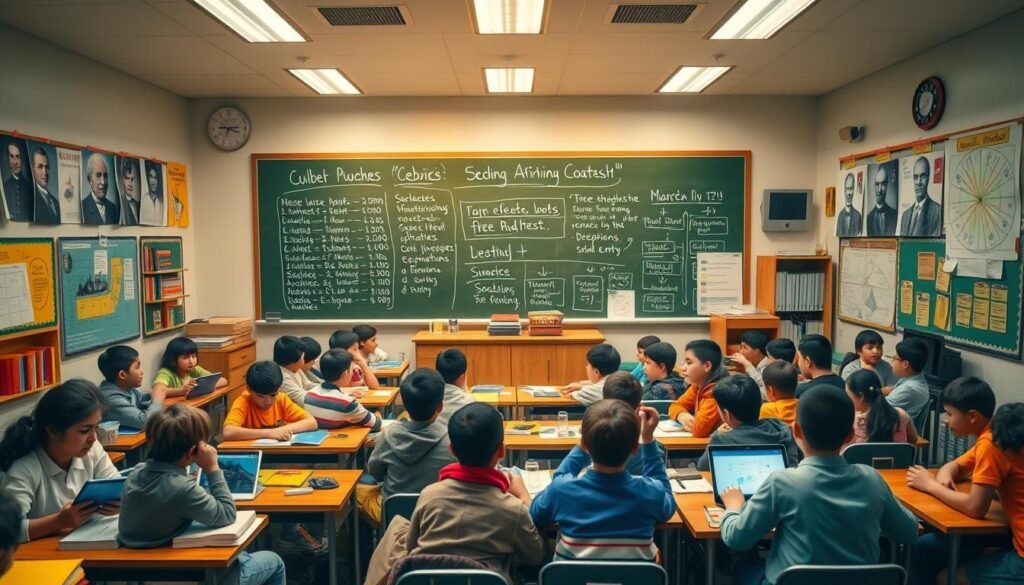
Discussions about education reform must also consider social media’s impact. It can quickly turn classroom discussions into big controversies. Schools need to teach students how to handle these topics wisely.
“The necessity to address controversial topics in a safe and purposeful classroom environment can no longer be ignored. We must prepare our students not just academically but also as participants in a democratic society.”
To move forward, we must rethink what and how we teach. By teaching controversial topics carefully, we can raise a generation that is engaged, informed, and caring.
Your knowledge of cultural literacy and support for better education policies are crucial. They help shape America’s education system towards a brighter, more inclusive future.
The Resignation Epidemic Among Educational Leaders: Symptoms of a Larger Issue
Recently, many top leaders in famous schools have left their jobs. These moves show more than just personal choices. They point to big problems in education that need quick fixes. You might wonder why leaders leave, especially in places meant for learning and growth.
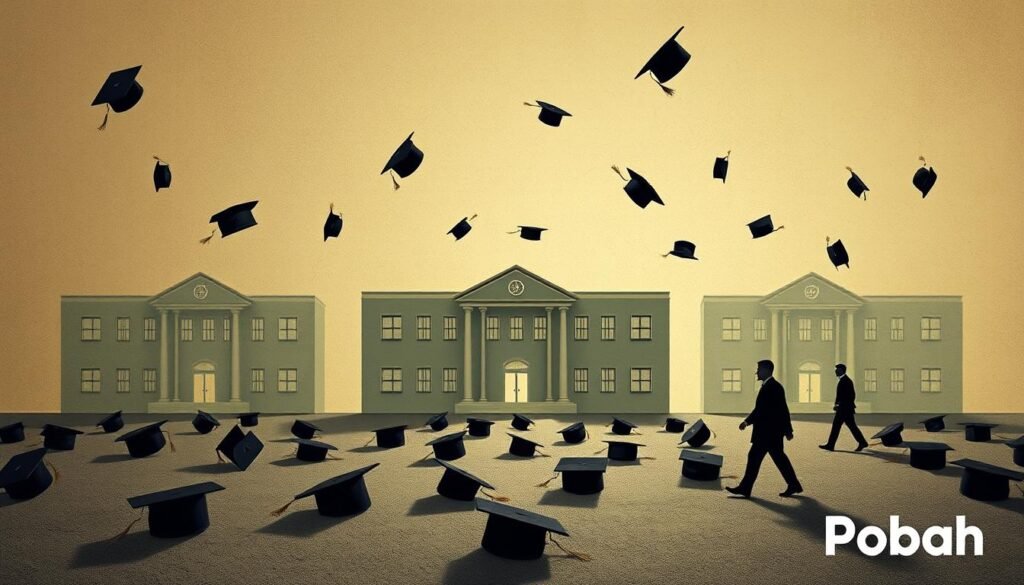
Systemic discrimination tests educational leaders every day. Leadership failures are not just random. They show deep problems that affect the whole education system. It’s key to see how these issues harm leaders and the whole academic community.
Investigation into Discrimination and Leadership Failures
The Department of Education has looked into many schools. They found ongoing discriminatory practices. These findings show a culture that might not support inclusive leadership. This affects everyone, from leaders to students and teachers.
Cultural and Political Turmoil Reflected in Campus Dynamics
Academic settings mirror society’s issues. The resignation wave seems like a single problem. But it’s really tied to cultural and political unrest in schools. This turmoil makes it hard for leaders to succeed.
Leaders try to change things, but without fixing the core issues, new problems arise. Think about how the resignation epidemic impacts education leadership. Understanding these patterns can help create better strategies. This could lead to more stable and effective leadership in schools.
Philanthropy in Education: The Unseen Impact of Donor Withdrawals
Philanthropy in education and donor withdrawals have a big impact on schools. Donors’ sudden changes in funding highlight their key role in education. When donors pull out, it affects more than just money. It changes what schools can offer and how they teach.
How Financial Decisions Shape Educational Opportunities
Donations help schools grow and offer more. They fund scholarships, hire teachers, and improve buildings. But, when donors stop giving, it can stop these plans. This leaves schools short on funds and students’ chances at learning at risk.
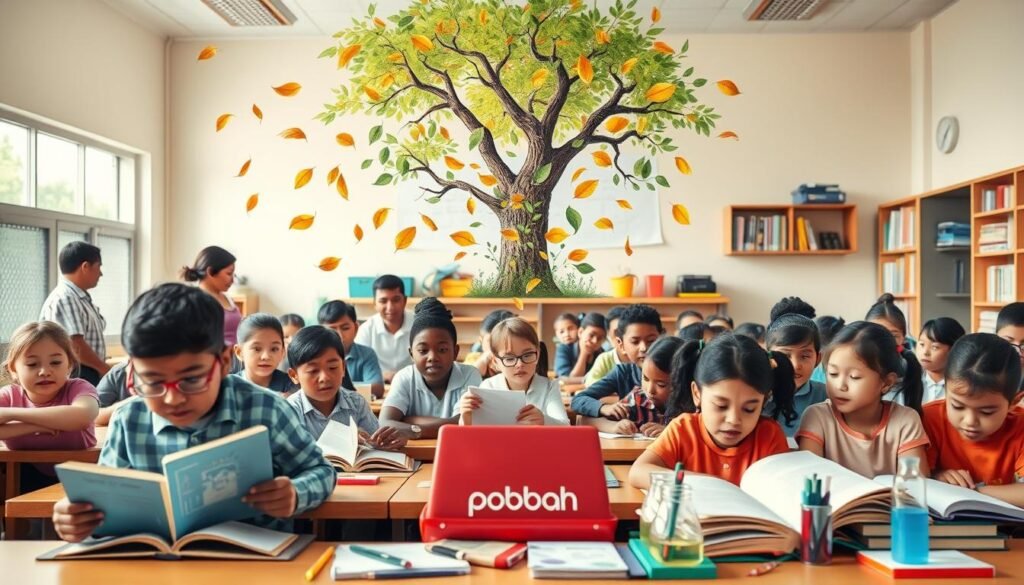
Exploring the Influence of Big Donors on Academic Freedom and Curriculum
Big donors can help or harm schools. They can fund research and support freedom in learning. But, they can also push for certain topics or views. This raises questions about who controls what’s taught and if it’s fair.
Donors can also use their money to change what schools teach. This puts schools in a tough spot. They must keep learning free while also getting the money they need.
The power in schools can change quickly with donors. This affects what students learn and the future workforce. It also shapes what we know and believe as a society.
In short, donations are crucial for schools but come with risks. Schools must plan carefully and stay independent. By being open and fair with donors, schools can protect their mission and teaching.
The Culture of Testing: How Accountability Measures Overshadow Learning
The culture of testing is deeply rooted in education. It raises important questions about what America’s schools really value. Looking closer at education reforms shows a big focus on tests, which can hurt real learning.
Examining the Consequences of Test-Centric Education Reforms
Over the years, education has shifted more towards standardized tests. This change, driven by laws like No Child Left Behind and Race to the Top, shows a big push for accountability. But these policies have big effects that go beyond just numbers.
Because of this focus on numbers, schools have narrowed their curriculum. Teachers often teach only what’s on the test, leaving out important skills like critical thinking. Interviews with teachers show a worrying trend where test scores are more important than learning itself.
The Pitfalls of Prioritizing Scores over Students’ Understanding
Putting too much emphasis on scores has big downsides. Critics say it hurts students’ learning and emotional health. Schools become places where standardization beats personal learning.
Also, schools that don’t meet test standards face harsh penalties. This hurts schools in poor areas and makes education worse for everyone. It also makes it hard for teachers to try new things in the classroom.
We need to think hard about whether testing is really helping students. Maybe it’s time to change education to focus more on understanding than just scores.
The Dynamics of Change: Case Studies in Education Reform and Resistance
The world of education is always changing. With each new change, we see both progress and challenges. Discussing education reform means talking about the dynamics of change. This is a key idea in books like Michael Fullan’s “The New Meaning of Educational Change.”
This text helps us understand the complex process of introducing knowledge-based curricula. It also shows how to deal with resistance in education.
Reforms ask for a big change from old ways to new, better methods. These new methods focus on deep knowledge, not just covering a lot of topics. But, changing how we teach is hard. It means teachers need to learn new things and think differently about teaching and learning.
Successes and Pitfalls in the Implementation of Knowledge-Based Curricula
Looking at education reform through case studies shows how important leadership is. Leaders at all levels play a big role in making change work. They help create an environment where knowledge-based curricula can succeed.
Leaders face challenges like skepticism and resistance. But they can guide schools to adopt new, better curricula. These curricula help students think critically and solve problems.
Examining Resistance to Change within the Teaching Profession
The teaching profession often resists big changes. This is because changes can make teachers feel less in control or unprepared. The way to beat this resistance in education is through open talks and working together on reforms.
This way, teachers feel included and valued in the changes happening in schools.
- Understanding the fear of obsolescence and loss of control can help mitigate resistance.
- Engagement in professional development and continuous learning can ease transitions.
- Recognition and respect for the professional expertise of teachers can foster a more collaborative atmosphere.
In conclusion, changing education needs a careful approach. By studying specific cases, we can learn how to manage change well. This ensures that education evolves to meet the needs of students and society in the future.
Conclusion
The state of American education shows a clear picture of challenges and crises. You now know about the issues affecting schools across the country. These include laws in over thirty percent of states against new teaching methods and the effects of No Child Left Behind.
There are also debates on teaching history, showing the need for change. The call for educational transformation is louder than ever.
The success of our society depends on well-educated teachers and students. Closing the knowledge gap is crucial and requires real solutions. It’s a challenge for all of us to make sure young people are well-informed and critical thinkers.
It’s important to support teachers in creating inclusive and critical thinking environments. This is key to overcoming obstacles that many American students face.
We need to work together for a better education system. It should be fair and provide strong learning opportunities. The points and solutions given offer a chance to improve lives through education.
It’s up to educators, policymakers, and community leaders to make this change. Together, we can ensure every student has the skills to succeed in the future.
FAQ
What is the central issue in America’s education crisis?
The main problem is the unfairness in education. This includes a knowledge gap and unequal access to learning. These issues are often ignored in talks about fixing education.
How does the knowledge gap impact reading comprehension in the American educational system?
The knowledge gap happens when teaching focuses on skills, not content. This makes it hard for students to understand new texts. It hits low-income students the hardest, as they often lack the background knowledge.
Why is fundamental knowledge undervalued in schools, and what are the consequences?
Schools focus too much on skills, not content. This leads to a system that fails to educate students well. It makes it hard for them to be informed and think critically, widening education gaps.
How crucial is a deep, rich curriculum in early education?
A rich curriculum in early education is key. It builds a strong knowledge base. Without it, vulnerable students miss out on opportunities for growth and learning.
What are the educational equity issues faced by students in diverse classrooms?
Students from low-income families face big challenges in diverse classrooms. They lack access to quality education and resources. This limits their ability to learn and creates unfair gaps in education.
What are the political challenges associated with deciding classroom content in America?
Deciding what to teach in classrooms is often political. Debates over essential knowledge are common. These debates can be tough, especially when trying to keep education neutral.
What signs suggest that there are larger systemic issues behind the resignation of educational leaders?
The recent wave of leaders leaving schools points to bigger problems. These issues reflect broader cultural and political issues. They show that the problems are not just in schools but in society too.
How do philanthropy and donor decisions impact education?
Donors play a big role in shaping education. They decide on curriculum and programs. When they pull out, it can change schools and affect students’ learning.
Why is the overemphasis on standardized testing in education a concern?
Too much focus on tests is bad. It can make learning shallow and ignore real growth. It can also limit creativity and critical thinking, hurting students’ development.
What resistance is faced during the implementation of knowledge-based curricula?
Changing to knowledge-based curricula is hard. Teachers worry about losing control and changing long-held practices. It’s tough to move to a focus on content knowledge.


